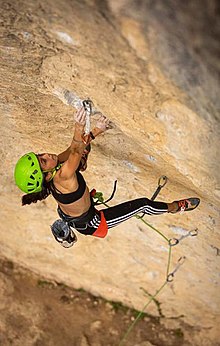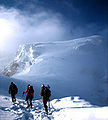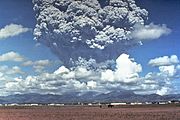| |
|
|
Introduction

A mountain is an elevated portion of the Earth's crust, generally with steep sides that show significant exposed bedrock. Although definitions vary, a mountain may differ from a plateau in having a limited summit area, and is usually higher than a hill, typically rising at least 300 metres (980 ft) above the surrounding land. A few mountains are isolated summits, but most occur in mountain ranges.
Mountains are formed through tectonic forces, erosion, or volcanism, which act on time scales of up to tens of millions of years. Once mountain building ceases, mountains are slowly leveled through the action of weathering, through slumping and other forms of mass wasting, as well as through erosion by rivers and glaciers.
High elevations on mountains produce colder climates than at sea level at similar latitude. These colder climates strongly affect the ecosystems of mountains: different elevations have different plants and animals. Because of the less hospitable terrain and climate, mountains tend to be used less for agriculture and more for resource extraction, such as mining and logging, along with recreation, such as mountain climbing and skiing.
The highest mountain on Earth is Mount Everest in the Himalayas of Asia, whose summit is 8,850 m (29,035 ft) above mean sea level. The highest known mountain on any planet in the Solar System is Olympus Mons on Mars at 21,171 m (69,459 ft). (Full article...)
Selected mountain-related landform

A mountain is an elevated portion of the Earth's crust, generally with steep sides that show significant exposed bedrock. Although definitions vary, a mountain may differ from a plateau in having a limited summit area, and is usually higher than a hill, typically rising at least 300 metres (980 ft) above the surrounding land. A few mountains are isolated summits, but most occur in mountain ranges.
Mountains are formed through tectonic forces, erosion, or volcanism, which act on time scales of up to tens of millions of years. Once mountain building ceases, mountains are slowly leveled through the action of weathering, through slumping and other forms of mass wasting, as well as through erosion by rivers and glaciers. (Full article...)
Selected mountain range
The Little Snowy Mountains are a small mountain range in central Montana about 25 miles (40 km) southeast of Lewistown. The range lies mostly in Fergus County, but the southern part of the range extends into Golden Valley and Musselshell counties.
The range is a lower continuation of the Big Snowy Mountains which lie immediately to the west. The small Pike Creek Hills are 12 miles (19 km) to the east. (Full article...)
Selected mountain type
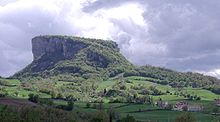
An inselberg or monadnock (/məˈnædnɒk/ mə-NAD-nok) is an isolated rock hill, knob, ridge, or small mountain that rises abruptly from a gently sloping or virtually level surrounding plain. In Southern Africa a similar formation of granite is known as a koppie, an Afrikaans word ("little head") from the Dutch diminutive word kopje. If the inselberg is dome-shaped and formed from granite or gneiss, it can also be called a bornhardt, though not all bornhardts are inselbergs. An inselberg results when a body of rock resistant to erosion, such as granite, occurring within a body of softer rocks, is exposed by differential erosion and lowering of the surrounding landscape. (Full article...)
Selected climbing article
Lead climbing (or leading) is a technique in rock climbing where the lead climber clips their rope to the climbing protection as they ascend a pitch of the climbing route, while their second (or belayer) remains at the base of the route belaying the rope to protect the lead climber in the event that they fall. The term is used to distinguish between the two roles, and the greater effort and increased risk, of the role of the lead climber.
Leading a climb is in contrast with top roping a climb, where even though there is still a second belaying the rope, the lead climber faces little or no risk in the event of a fall and does not need to clip into any protection as the rope is already anchored to the top of the route (i.e. if they fall off, they just hang from the rope). (Full article...)
Related portals
General images
Selected skiing article
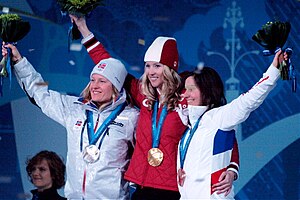
Freestyle skiing is one of the six skiing disciplines contested at the Winter Olympic Games, and one of the youngest. In 1924, the first Winter Olympics featured Nordic skiing disciplines (cross-country skiing, ski jumping, and Nordic combined), while alpine skiing was first contested in 1936. Only at the 1992 Winter Olympics, in Albertville, France, were freestyle skiing events first held as official medal events. Before that, freestyle skiing was contested at the 1988 Winter Olympics as a demonstration sport, consisting of events for both men and women in three variants: moguls, aerials and ski ballet. In Albertville, moguls was the first-ever official freestyle skiing medal event; aerials and ski ballet were also held but still as demonstration events. The growing popularity of aerials convinced the International Olympic Committee (IOC) to add this freestyle discipline to the 1994 Winter Olympics official program. Moguls and aerials have thus been contested at every Winter Games since. Ski cross inclusion in the Winter Olympics program was approved at an IOC Executive Board meeting in November 2006, and the first events were held at the 2010 Winter Olympics.
At the 2002 Winter Olympics, two days after Steve Bradbury gave Australia its first-ever Winter Olympic gold medal, Alisa Camplin won the freestyle aerials event, becoming the first Australian woman to win gold at the Winter Games; four years later, she collected a second consecutive medal, a bronze. In 2010, the third Olympics hosted by Canada finally consecrated a Canadian athlete as Olympic champion: Alexandre Bilodeau took the gold medal in the men's moguls, overcoming defending champion Dale Begg-Smith of Australia. Kari Traa of Norway has won three medals (one gold, one silver, one bronze) in three successive Games, more than any other freestyle skier at the Winter Olympics. Alexandre Bilodeau and David Wise are the most successful male freestyle skiers, with two gold medals. Alexandre Bilodeau was also the first freestyle skier to win back to back gold medals when he won gold in the 2010 and 2014 moguls. The youngest freestyle skier to win an Olympic medal is Swiss Mathilde Gremaud, who secured a silver in 2018 with 18 years old, while Tatjana Mittermayer of Germany is the oldest medalist, following her silver in the 1998 moguls event, aged 33. (Full article...)
Subcategories
Need help?
Do you have a question about Mountains that you can't find the answer to? Consider asking it at the Wikipedia reference desk.
Get involved
For editor resources and to collaborate with other editors on improving Wikipedia's Mountains-related articles, see WikiProject Mountains.
Topics

- Africa: Atlas • Kilimanjaro • Mount Kenya massif • Ruwenzori Mountains
- America: Andes • Appalachians • Cascades • Cordilleras • Rockies • Sierra Nevada
- Antarctica: Sentinel Range
- Asia: Altai • Himalaya • Hindu Kush • Caucasus • Karakoram • Pamir
- Australia and Oceania: Maoke Mountains • New Zealand Alps • Snowy Mountains
- Europe: Alps • Ardennes • Balkans • Highlands • Jura • Carpathians • Pyrenees • Scandinavian Mountains • Urals • Vosges

- Alps: Piz Badile • Mont Blanc • Petit Dru • Dufourspitze • Eiger • Großglockner • Grandes Jorasses • Jungfrau • Königspitze • Matterhorn • Mönch • Ortler • Watzmann • Drei Zinnen • Zugspitze
- Andes: Aconcagua • Alpamayo • Chimborazo • Cotopaxi • Fitz Roy • Nevado Huascarán • Illimani • Sajama • Ojos del Salado • Siula Grande • Cerro Torre • Yerupaja
- Himalayas: Eight-thousanders – Mount Everest • K2 • Kangchenjunga • Lhotse • Makalu • Cho Oyu • Dhaulagiri • Manaslu • Nanga Parbat • Annapurna I • Hidden Peak • Broad Peak • Gasherbrum II • Shishapangma – Other – Ama Dablam • Chogolisa • Masherbrum • Shivling
- Rocky Mountains: Mount Chephren • Mount Elbert • Mount Logan • Denali • Mount Robson
- Volcanos: Etna • Eldfell • Hohentwiel • Mauna Kea • Pinatubo • Puʻu ʻŌʻō • Mount St. Helens • Stromboli • Mount Unzen
Flora and fauna

- Plants: Alpine Rock-Jasmine • Hairy Alpenrose • Edelweiss • Great Yellow Gentian • Glacier Crowfoot • Wulfenia • Dwarf Willow • Queen of the Andes • Arolla Pine
- Animals: Red-billed Chough • Alpine marmot • Alpine Salamander • Rock Ptarmigan • Alpine Ibex • Andean Condor • Bearded Vulture • Alpine Chough • Chamois • Mountain Burnet • European Viper • Himalayan Tahr • Wallcreeper • White-winged Snowfinch • Golden Eagle • Northern Bald Ibis • Yak
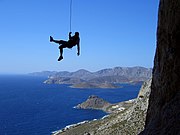
- Equipment: Ascenders • Belay devices • Carabiners • Maillons • Harnesses • Hexes • Nuts • Quickdraws • Ropes • Shoes • SLCDs • Slings • Tricams
- Techniques: Abseiling • Redpointing • Anchor • Mantle • Top roping • Climbing grade • Climbing route
- Types of climbing: Big wall climbing • Bouldering • Competition climbing • Free climbing • Ice climbing • Mountain climbing • Rock climbing • Schrofen • Sport climbing
- Klettersteigs: Mannlgrat
- Climbers: Kurt Albert • Pierre Allain •John Bachar • Henry Barber • Catherine Destivelle • Patrick Edlinger • John Gill • Stefan Glowacz • Wolfgang Güllich • Lynn Hill • Alex Honnold • Alexander Huber • John Long • Jeff Lowe • Magnus Midtbø • Adam Ondra • Dean Potter • Alain Robert • Chris Sharma • Todd Skinner • Ueli Steck • Other climbers

- Mountaineering: Alpine Clubs • Boots • Crampons • Ice axes • Mountain huts • Mountain rescue • Ropes • Rucksacks
- Pioneers: Christian Almer • Melchior Anderegg • Hermann von Barth • Walter Bonatti • Meta Brevoort • William Martin Conway • Angelo Dibona • Hans Dülfer • Paul Grohmann • Adolphus Warburton Moore • Paul Preuss • Ludwig Purtscheller • Schlagintweit brothers • Leslie Stephen • Gottlieb Samuel Studer • Tenzig Norgay • Herbert Tichy • Lucy Walker • Edward Whymper • Georg Winkler • Matthias Zurbriggen
- High-altitude mountaineers: Chris Bonington • Hermann Buhl • Kurt Diemberger • Ralf Dujmovits • Günther Dyhrenfurth • Maurice Herzog • Sir Edmund Hillary • Sandy Irvine • Gerlinde Kaltenbrunner • George Mallory • Nives Meroi • Reinhold Messner • Simone Moro • Oh Eun-sun • Edurne Pasaban • Wanda Rutkiewicz • Lionel Terray • Um Hong-Gil • Stephen Venables • Ed Viesturs • Other mountaineers
- Publicists: Karl Blodig • W. A. B. Coolidge • David Breashears • Jon Krakauer • Gaston Rébuffat
- Alps: Eiger climbing history • Exploration of the High Alps • Golden age of alpinism • Silver age of alpinism • Timeline of climbing the Matterhorn
- Himalayas: 1922 British Mount Everest expedition • 1924 British Mount Everest expedition • 1953 British Mount Everest expedition • 1986 K2 disaster • 1996 Mount Everest disaster • 2008 K2 disaster • Timeline of climbing Mount Everest
- Museums: Alpine Club Museum • Messner Mountain Museum
Lists of mountains
Recognized content
- Featured content
- Good content
 Amak Volcano
Amak Volcano Ben Nevis
Ben Nevis Gerlachovský štít
Gerlachovský štít Glacier Peak
Glacier Peak Hualālai
Hualālai Huangshan
Huangshan Kohala (mountain)
Kohala (mountain) Mont Aiguille
Mont Aiguille Mont Blanc massif
Mont Blanc massif Montpelier Hill
Montpelier Hill Mount Adams (Washington)
Mount Adams (Washington) Mount Bailey (Oregon)
Mount Bailey (Oregon) Mount Baker
Mount Baker Mount Cleveland (Alaska)
Mount Cleveland (Alaska) Mount Edziza volcanic complex
Mount Edziza volcanic complex Mount Elbert
Mount Elbert Mount Garibaldi
Mount Garibaldi Mount Hood
Mount Hood Mount Kenya
Mount Kenya Mount Rainier
Mount Rainier Mount Redoubt
Mount Redoubt Mount Tehama
Mount Tehama Mount Thielsen
Mount Thielsen Mount Vesuvius
Mount Vesuvius Pinkham Notch
Pinkham Notch Roxy Ann Peak
Roxy Ann Peak Silverthrone Caldera
Silverthrone Caldera Snowdon
Snowdon Wells Gray-Clearwater volcanic field
Wells Gray-Clearwater volcanic field Wilkins Peak
Wilkins Peak Yamsay Mountain
Yamsay Mountain
Associated Wikimedia
The following Wikimedia Foundation sister projects provide more on this subject:
-
Commons
Free media repository -
Wikibooks
Free textbooks and manuals -
Wikidata
Free knowledge base -
Wikinews
Free-content news -
Wikiquote
Collection of quotations -
Wikisource
Free-content library -
Wikiversity
Free learning tools -
Wikivoyage
Free travel guide -
Wiktionary
Dictionary and thesaurus

